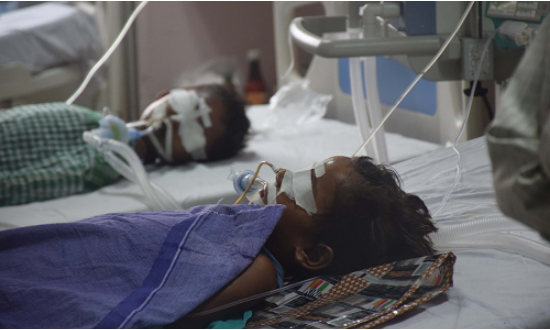Uttar Pradesh government has once again embarked on a campaign to vaccinate kids in the state against the deadly Japanese Encephalitis and Acute Encephalitis Syndrome. This month a total 33 lakh children in 38 districts are being vaccinated. But vaccination drives in the past have failed miserably in combating the disease. What is the Gorakhpur mystery that makes JE undefeatable and what can Uttar Pradesh learn from its own past?
Gorakhpur (ISJ) – Every year Gorakhpur in Uttar Pradesh comes into news for wrong reasons. Since 1978, there have been hundreds of deaths every year during or after the monsoon period due to Japanese Encephalitis (JE) or commonly known as Kala Azar. According to records of the state-run Baba Raghav Das (BRD) Medical College, one of the largest hospitals in the state, which has facilities for treatment of Japanese Encephalitis, around 25,000 children have died due to JE and acute encephalitis syndrome (AES).
During monsoon period, the bowl-shaped landscape of eastern Uttar Pradesh collects the rainwater. This stagnated rainwater turns the perfect breeding ground for Culex mosquitoes, which carry the JE virus from animals such as pigs to humans. Besides, high temperatures and dense humidity makes the transmission of the JE virus easier, according to doctors in Gorakhpur. JE is caused by JE virus carried by Culex mosquitoes. AES, which includes JE, is a group of clinically similar neurological disorder caused by different germs and parasites.
Another reason for Gorakhpur becoming the epicentre of the disease is because it has a dedicated tertiary hospital for treatment of JE.
“If you go by the numbers, you will see the number of JE cases is higher in the adjoining districts such as Kushingar or Deoria. But those adjoining districts don’t have dedicated hospital. The JE inflicts whole of Eastern Uttar Pradesh and the patients head to Gorakhpur,” said a senior central government official on the condition of anonymity.
BRD Medical College and its associated Nehru Hospital is the dedicated tertiary hospital of Gorakhpur and it had come into limelight in August, 2017 when 60 children died within five days, allegedly due to lack of liquid oxygen. It again came in the news when in the first five days of November last year, 70 children have died at the hospital. Most cases were allegedly related to premature birth, low birth weight and septicemia.
Allocations by the Union Health Ministry to Pradesh government under the National Health Mission, have been significantly reduced over the years. The budget demand by UP for AES and JE for 2016-17 was Rs 30.40 crore, of which only Rs 10.19 crore was approved by the Centre. Shockingly, in 2017-18, the budget demand from UP government was decreased to Rs 20.01 crore, while the central government approved just Rs 5.78 crore — barely 29 per cent of the proposed amount.
The total budget for medicines, materials and supplies for the BRD Medical College and associated hospital in 2015-16 was Rs 8.85 crore. While the number of patients has been increasing, the funding has been decreased to just Rs. 7.92 crore in 2017-18. Moreover, local officials repeatedly complained that the state governments do not provide sufficient funds on time for purchase of medical supplies.
“BRD Medical College has set a depressing world record. Nowhere in the world has so many kids died due to JE under one roof. The causality numbers that we get every year through media and government sources is just tip of the iceberg. The actual number is much higher,” said Dr. R N Singh, Senior Paediatrician in Gorakhpur.
The central government has made immunisation against JE part of routine immunisation in 198 endemic Indian districts. However, a 2015 survey stated that only 43 percent of Gorakhpur division’s eligible children have taken the two recommended doses of JE vaccination.
“After our relentless campaign government finally agreed to import vaccines from China in 2005. 65 lakh vaccines were administered in May 2006. But here they did a mistake. JE Vaccine should be given every year but they waited till 2010 for importing next batch of 75 lakh vaccines. We lost the battle due to this four year gap,” Singh added.
According to a report by the Directorate of National Vector Borne Diseases Control Programme (NVBDCP), 26,686 cases of encephalitis were reported in Uttar Pradesh between 2010 and August 2017. Of this, 24,668 cases were of AES and 4,093 persons died because of it. On the other hand, there were 308 recorded JE deaths in the state — 15 percent of the total people who suffered from JE between 2010-2017.
Health activists also say, health workers need to be made more effective as they are the first line of defence. “A sustained cleanliness campaign needs to be conducted across Gorakhpur and its adjoining districts. Currently, you can see garbage heaps everywhere. This has to stop. Government need to take preventive measures and the first step is cleanliness. Second, health workers need to be trained more thoroughly. They need to be instructed in in the local dialect – Purvi bhasha, so that they can understand the whole subject. If they understand it completely, the common people will understand it too,” said a health activist, who has been working at vaccination program in Deoria.
The primary health centres (PHCs) in Gorakhpur and its adjoining areas are not effective as it should be in dealing with JE symptoms. State government’s officials readily concede that health workers and doctors working at such PHCs need to be given specialised training to deal with JE and AES. “Currently, cases where the patient may develop JE are immediately shifted to BRD Medical College. This is not a sustainable way. The PHCs should be able to handle non-serious cases effectively on their own,” said a state health department official.


